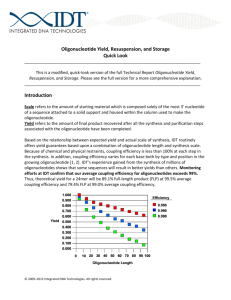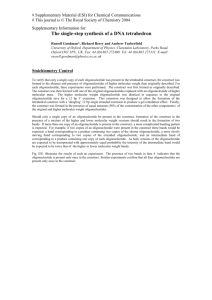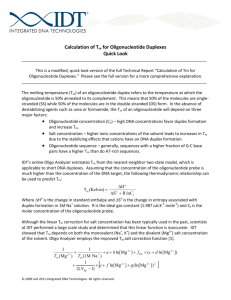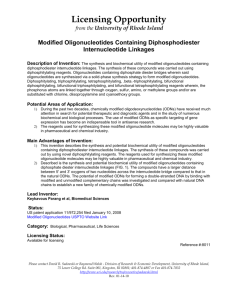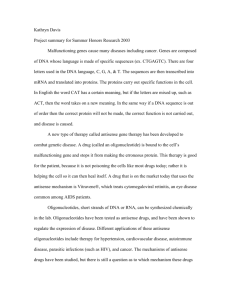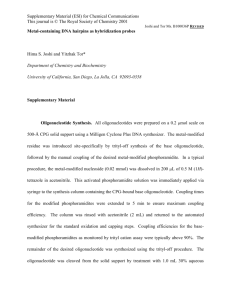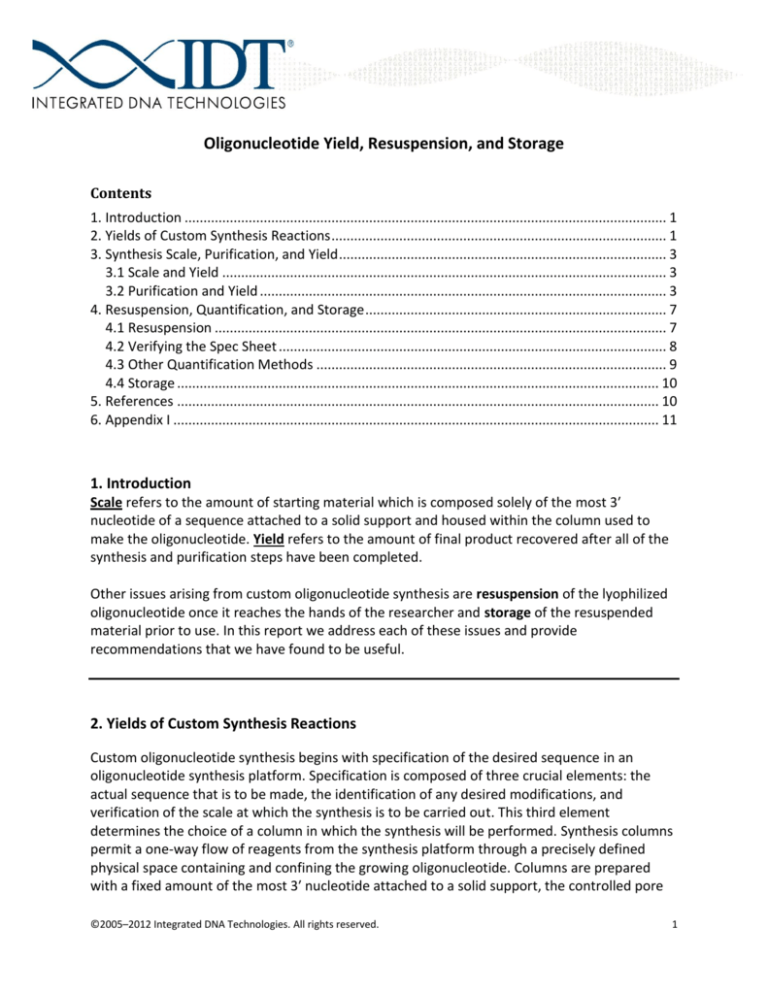
Oligonucleotide Yield, Resuspension, and Storage
Contents
1. Introduction ................................................................................................................................ 1
2. Yields of Custom Synthesis Reactions ......................................................................................... 1
3. Synthesis Scale, Purification, and Yield ....................................................................................... 3
3.1 Scale and Yield ...................................................................................................................... 3
3.2 Purification and Yield ............................................................................................................ 3
4. Resuspension, Quantification, and Storage ................................................................................ 7
4.1 Resuspension ........................................................................................................................ 7
4.2 Verifying the Spec Sheet ....................................................................................................... 8
4.3 Other Quantification Methods ............................................................................................. 9
4.4 Storage ................................................................................................................................ 10
5. References ................................................................................................................................ 10
6. Appendix I ................................................................................................................................. 11
1. Introduction
Scale refers to the amount of starting material which is composed solely of the most 3′
nucleotide of a sequence attached to a solid support and housed within the column used to
make the oligonucleotide. Yield refers to the amount of final product recovered after all of the
synthesis and purification steps have been completed.
Other issues arising from custom oligonucleotide synthesis are resuspension of the lyophilized
oligonucleotide once it reaches the hands of the researcher and storage of the resuspended
material prior to use. In this report we address each of these issues and provide
recommendations that we have found to be useful.
2. Yields of Custom Synthesis Reactions
Custom oligonucleotide synthesis begins with specification of the desired sequence in an
oligonucleotide synthesis platform. Specification is composed of three crucial elements: the
actual sequence that is to be made, the identification of any desired modifications, and
verification of the scale at which the synthesis is to be carried out. This third element
determines the choice of a column in which the synthesis will be performed. Synthesis columns
permit a one-way flow of reagents from the synthesis platform through a precisely defined
physical space containing and confining the growing oligonucleotide. Columns are prepared
with a fixed amount of the most 3′ nucleotide attached to a solid support, the controlled pore
©2005–2012 Integrated DNA Technologies. All rights reserved.
1
glass (CPG) bead. It is the amount of the most 3′ nucleotide present in the column, in
nanomoles, that constitutes the synthesis scale.
Once the column is properly prepared with the correct 3′ nucleotide at the desired scale, it is
placed in the synthesis platform and the rest of the oligonucleotide is synthesized by adding
each base of the specified sequence one at a time in the 3′→5′ direction. Because of chemical
and physical restraints, the coupling efficiency is less than 100% at each step in the synthesis. In
addition, coupling efficiency varies for each base both by type and position in the growing
oligonucleotide [1, 2]. Experience gained at Integrated DNA Technologies from the synthesis of
millions of oligonucleotides shows that some sequences will result in better yields than others.
For example, one 24mer may give twice the yield of another 24mer even if they are synthesized
on the same machine, the same day, and with the same reagents. Another source of yield
variation can be the specific machine on which the synthesis is carried out. For this reason,
Integrated DNA Technologies maintains a rigorous maintenance and monitoring program
designed to keep each synthesis platform functioning at peak efficiency at all times.
Even with the variables of custom oligonucleotide synthesis, it is possible to derive a theoretical
yield for any given synthesis. Making the operational assumption that coupling efficiency for
each nucleotide will be constant regardless of type and location, theoretical yield is given as,
Y = (eff)n-1
where (eff) is the average coupling efficiency and n is the number of bases in the
oligonucleotide. Monitoring efforts at Integrated DNA Technologies confirm that our average
coupling efficiency exceeds 99% for all oligonucleotides. Thus, theoretical yield for a 24mer will
be 89.1% full-length product (FLP) at 99.5% average coupling efficiency and 79.4% FLP at 99.0%
average coupling efficiency. A
more complete picture of the
relationship between coupling
efficiency and %FLP for
oligonucleotides of various
lengths is shown in Figure 1.
Two aspects of this relationship
are readily apparent. First, the
cumulative effect of even a
0.5% average coupling failure
rate can be dramatic for longer
oligonucleotides. Second, minor
increases in average coupling
failure rates will have a
Figure 1. Relationship between average coupling efficiency and
substantial net effect on even
synthesis yield (Y = (eff)n-1) over a range of oligonucleotide lengths.
average length
oligonucleotides. It is for this
©2005–2012 Integrated DNA Technologies. All rights reserved.
2
reason that Integrated DNA Technologies maintains constant, real-time monitoring of every
custom synthesis reaction on every synthesis platform.
3. Synthesis Scale, Purification, and Yield
3.1 Scale and Yield
Integrated DNA Technologies routinely offers yield guarantees based upon a combination of
oligonucleotide length and synthesis scale. These guarantees are shown in Table 1. Synthesis of
very long oligonucleotides (those greater than 60 bases) is problematic. Thus, Integrated DNA
Technologies does not offer any yield guarantees for oligonucleotides greater than 60 bases at
our highest synthesis scale and greater than 100 bases at any scale.
Table 1
Yield Guarantees (in Optical Density Units; ODs) by Synthesis Scale
Length
5–9
10–14
15–19
20–60
61–80
81–100
Unmodified, Desalted
Scale
25 nmol
3
3
100 nmol
2
4
6
6
250 nmol
1 µmol
5
5
19
15
15
15
10
15
30
45
45
45
Modifications can affect yield; please contact Customer Care for
yield on specific modified oligonucleotides (800-328-2661) or
custcare@idtdna.com
3.2 Purification and Yield
As a general rule, IDT recommends that any oligonucleotide longer than 40 bases should
receive further purification. In addition, for demanding applications such as site-directed
mutagenesis, cloning, and gel-shift protein-binding assays, additional purification is
recommended even for oligonucleotides shorter than 40 bases. Our experience has shown that
taking the time to purify an oligonucleotide used in the more demanding applications saves far
more in terms of the precious commodities of time and research funds than it costs on the
front end. Thus, additional purification should be considered for any oligonucleotide that is to
be used for any application other than routine PCR or DNA sequencing.
©2005–2012 Integrated DNA Technologies. All rights reserved.
3
IDT offers preparative-scale purification via denaturing polyacrylamide/urea gels (PAGE) and
HPLC. While both of these methods will result in greatly increased oligonucleotide purity, one
approach to purification may be superior to the other depending upon the intended use of the
oligonucleotide and the presence or absence of modifications. A summary of general
recommendations is presented in Table 2 below. Please note that additional purification will
result in a decrease in final oligonucleotide yield. Yield guarantees for various combinations of
synthesis scale and purification are presented in Table 3.
Table 2
General Oligonucleotide Purification Recommendations
PAGE
Basis of
Purification:
Mass Recovery
(estimated):
Pros
Cons
Recommendation
IE-HPLC*
Length
Purification Method
RP-HPLC*
Hydrophobicity
20–50%
40–70%
30–60%
Best method to
enrich the proportion
of full-length product
Only for syntheses ≤
1 µmole
Best method for
oligonucleotides with a
hydrophobic group
Does not remove (n-1)-mers
very efficiently
Use for any
oligonucleotide ≥ 50
bases
Use for oligonucleotides ≤ 50
bases if intended for:
- Site directed mutagenesis
- Cloning, screening
- Gel shift assays
Good means of
purifying large scale
syntheses (≥10 µmole)
Not good for
oligonucleotides ≥ 80
bases
Use for large scale
syntheses and for in
vivo applications
Length
Use with any oligonucleotide
modified with a hydrophobic
group; i.e., Biotin, Digoxigenin,
NHS-ester conjugates,
Fluorescent dyes
*RP-HPLC (reverse-phase), IE-HPLC (ion-exchange)
©2005–2012 Integrated DNA Technologies. All rights reserved.
4
Table 3
Yield Guarantees (in Optical Density Units; ODs) by Synthesis Scale and Method of
Purification. Note that these guarantees refer to unmodified oligonucleotides
Length
5–9
10–14
15–19
20–60
61–65
66–70
71–75
76–80
81–100
Length
5–9
10–14
15–19
20–50
51–60
61–65
66–70
71–75
76–80
81–100
Unmodified, HPLC-purified
Scale
25 nmol
100 nmol
250 nmol
2
1
3
1
4
1
4
1
4
1
3
1
3
1
2
2
Unmodified, PAGE-purified
Scale
25 nmol
100 nmol
250 nmol
0
0.5
1
0.5
1.5
1
2
0.5
2
0.5
2
0.5
1.5
0.5
1.5
0.5
1
1
1 µmol
2.5
5
10
20
20
15
15
10
10
1 µmol
1.3
2.5
5
10
10
10
7.5
7.5
5
5
Modifications can affect yield; please contact Customer Care for
yield on specific modified oligonucleotides (800-328-2661) or
custcare@idtdna.com
In specific instances, IDT requires additional purification of an oligonucleotide synthesis. One of
these is any oligonucleotide of any length that is modified with phosphorothioate intended for
use as an anti-sense agent. The impurities resulting from phosphorothioate syntheses are toxic
in tissue culture as well as in in vivo applications. Other circumstances in which IDT requires
additional purification of an oligonucleotide synthesis are presented in Table 4 below. Also
presented in Table 4 are circumstances for which we strongly recommend additional
purification
©2005–2012 Integrated DNA Technologies. All rights reserved.
5
Table 4
IDT Purification Requirements and Recommendations
5′ Modifications
Internal Modifications
3′ Modifications
Biotin dT
Biotin-TEG
Dual Biotin
Biotin-TEG
Fluorescein dT
Biotin dT
Dabcyl
I-Linker
Fluorescein dT
*Bodipy® 630/650-X
5-Br dU
5-Br dU
*Bodipy® 650/665
*Bodipy® 630/650-X
*Bodipy®
630/650-X
Cy3™ CPG
*Bodipy® 650/665
*Bodipy® 650/665
Cy5™ CPG
Cy3™
2,6,-Diaminopurine
Cy5.5™ CPG
Purification
Cy5™
JOE NHS
Digoxigenin NHS
Is
Cy5.5™
*Oregon Green™ 488-X
JOE NHS
Required
2,6,-Diaminopurine
*Oregon Green™ 514 *Oregon Green™ 488-X
Digoxigenin NHS
*Rhodamine Green-X *Oregon Green™ 514
JOE NHS
*Rhodamine Red-X
*Rhodamine Green-X
*Oregon Green™ 488-X
ROX NHS
*Rhodamine Red-X
*Oregon Green™ 514
TAMRA NHS
ROX NHS
*Rhodamine Green-X
Texas Red-X NHS
TAMRA CPG/NHS
*Rhodamine Red-X
Texas Red-X NHS
ROX NHS
TAMRA NHS
Texas Red-X NHS
Purification
Is
Optional
Acrydite™
Amino C6
Amino C12
Amino dT
2-Aminopurine
Biotin
C3 Spacer
dSpacer
6-FAM
HEX
Inosine
5-Me-dC
5-Nitroindole
Phosphate
Spacer 18
TET
Thiol C6
Uridine
Uni-Link Amino
Amino dT
2-Aminopurine
C3 Spacer
dSpacer
Inosine
5-Me-dC
5-Nitroindole
Spacer 18
Uridine
Amino C7
Biotin
Dideoxycytidine
6-FAM
Inosine
Inverted dT
Phosphate
3' Ribo Bases
Thiol C3
Uridine
* NHS ester dye from Molecular Probes, Inc.
©2005–2012 Integrated DNA Technologies. All rights reserved.
6
4. Resuspension, Quantification, and Storage
4.1 Resuspension
Oligonucleotides are shipped in dry (lyophilized) form unless otherwise requested. Dried DNA is
usually very easy to resuspend in an aqueous solution. However, not all oligonucleotides dry
identically and some can take a bit more time to completely go into solution than others. In
addition, if the oligonucleotide solution freezes during the dry-down process in the Speed-Vac it
will appear as a white powder similar in appearance to a piece of tissue or a kimwipe. In such
cases it is possible for the dried oligonucleotide to become dislodged from the tube during
shipping. Thus, it is very important to spin every oligonucleotide prior to opening the tube for
resuspension.
We recommend using TE buffer (10 mM Tris pH 8.0; 0.1 mM EDTA; pH 8.0) because the buffer
will maintain a constant pH. The oligo should not be exposed to conditions that are either too
acidic or too basic. Alternative, sterile water can be used for resuspending dry oligonucleotides.
If using water for resuspension, be sure to use only nuclease-free water, pH 7.0 (HPLC-grade is
preferable). DEPC water will harm oligonucleotides and water from deionizing systems can be
acidic with pH as low as 5.0.
Oligonucleotides should be aliquoted into portions for immediate use and those for longer term
storage in order to avoid contamination. Stock concentrations can be made using the yield
information contained on the “spec sheet.” There you will find the actual yield of the
oligonucleotide synthesis in three forms: optical density (OD) units; mass in milligrams (mg);
and copy number in nanomoles (nm). We routinely resuspend dry oligonucleotides to a storage
stock of 100 μM and then dilute working stocks accordingly. Adding TE or water at ten times
the number of nanomoles will give a 100 μM final concentration. This concentration provides
100 pmoles of oligonucleotide per μL. Most PCR reactions will use 10 to 50 pmoles of each
primer per reaction.
To make a 100 M concentration: Take the number of nmoles of oligo in the tube and multiply
that by 10. This number will be the number of L of buffer to add to get a 100M solution. For
example, if you have 9 nmoles of oligo, add 90 L of buffer to make a 100 M solution.
For those researchers who prefer to work in mass units, the amount of oligonucleotide present
in each tube in OD units and weight can be used. A 20mer oligonucleotide primer with random
base composition will have a molecular weight of ~6100 and a molar extinction coefficient of
196900 L/mole-cm. 1 OD260 unit of this oligonucleotide will therefore correspond to 31 μg, or
5 nmoles, of DNA. Dissolving 500 μg of DNA (16 OD units) in 500 μL of TE will yield a stock
primer concentration of 1 μg/μL, or about a 160 μM solution. This converts to 160 pmoles of
oligonucleotide per μL. Most PCR reactions set up using mass units will use about 60 ng of each
primer. Working stocks should be set up accordingly. A dilution calculator is also available in
SciTools on the IDT website.
©2005–2012 Integrated DNA Technologies. All rights reserved.
7
An oligo can be stored at any concentration. However, concentrations lower than 1 µM may
change over time as some of the oligo may be absorbed into the plastic of the tube. In addition,
a 5–10 mM solution is generally the highest concentration at which an oligo will go into
solution.
For hard to suspend oligos, heat the oligo at 55o C for 1–5 minutes, then thoroughly vortex. If
this does not work, the tube might have Trityl (flakey appearance) or CPG (a pellet at bottom of
tube). Neither of these should affect the performance of the oligo, and both can be removed
with a Sephadex G50 column, or by removing the supernatant.
4.2 Verifying the Spec Sheet
The heterocyclic ring structures in DNA and RNA absorb light with a maximum absorbance near
260 nanometers (nm). The most accurate means of assessing the amount of oligonucleotide
present following synthesis is to measure the optical density of the final product at 260 nm.
This value is provided on the spec sheet and it is determined only after purification since
unincorporated nucleotides and protecting groups can lead to inaccurate estimates of
oligonucleotide mass.
While an estimate of mass will suffice for many applications in which oligonucleotides are used,
it may be desirable for the researcher to verify mass after receiving the synthesis. One OD260
unit is defined as the amount of oligonucleotide which, when resuspended in a volume of
1.0 mL, results in an absorbance of 1.0 when measured at 260 nm in a 1 cm path-length quartz
cuvette. Once an oligonucleotide is resuspended according to the data provided on the spec
sheet, replicate samples can be measured in a spectrophotometer at 260 nm and the mass
amount can be calculated using the molar extinction coefficient, ε.
The relationship between measured OD260, molar extinction coefficient (ε260), and
oligonucleotide concentration is given as,
OD260 = ε260 * Concentration
Molar extinction coefficient is a unique physical property of every oligonucleotide determined
by the sequence. Purine nucleotides will absorb more strongly than pyrimidine nucleotides
regardless of whether they occur in DNA or RNA. ε260 values for both DNA and RNA nucleotides
are,
dA = 15,400, dC = 7,400, dG = 11,500, dT = 8,700
rA = 15,400, rC = 7,200, rG = 11,500, rU = 9,900
in L/mole-cm [3, 4].
However, interactions between neighboring bases alter absorbance in the same manner as
such neighbor effect will alter the melting temperature (Tm) of DNA:DNA and RNA:DNA bases
pairing. Thus, extinction coefficient is ultimately determined both by base composition and
©2005–2012 Integrated DNA Technologies. All rights reserved.
8
base order. Taking base stacking interactions into account, nearest-neighbor values for ε260
among dinucleotides are;
5′→3′
dA
dC
dG
dT
dA
27,400
21,200
25,200
23,400
dC
21,200
14,600
17,600
16,200
dG
25,000
18,000
21,600
19,000
dT
22,800
15,200
20,000
16,800
5′→3′
rA
rC
rG
rU
rA
27,400
21,000
25,200
24,600
rC
21,000
14,200
17,400
17,200
rG
25,000
17,800
21,600
20,000
rU
24,000
16,200
21,200
19,600
again, in L/mole-cm [5]. In general, then, calculation of the extinction coefficient of an
oligonucleotide of length n can be given by the expression,
1
2
ε260 = ∑ (ε nearest neighbor) – ∑ (ε individual)
n–1
(1)
n–1
where the second term is a necessary correction for internal bases being counted more than
once when nearest-neighbor doublets are summed. A numerical example of this calculation is
presented in Appendix I.
Finally, oligonucleotide modifications such as fluorescent dyes increase OD260 absorbance
values. When calculating extinction coefficients for modified oligonucleotides, it is important to
use values for OD260 and not the maximum absorbance of the modification. Correct molar
extinction coefficients for any modified or unmodified oligonucleotide can be obtained using
the on-line OligoAnalyzer 3.0 tool available in SciTools on the IDT website.
4.3 Other Quantification Methods
As noted, the most reliable means of determining oligonucleotide mass and concentration is to
use OD260. However, such estimates can also be obtained by running oligonucleotides against
known mass standards on polyacrylamide gels. The best results will be achieved using
denaturing urea-based gels (7 M urea, 1X TBE) as these gels will, for the most part, eliminate
the problem of secondary structure formation. DNA bands can be visualized using UV
backshadowing against a TLC plate where the DNA will appear as dark bands against a light
background. At Integrated DNA Technologies we examine every oligonucleotide synthesis at
the 250 nmole scale or larger using this method. While it is a reasonably reliable method, UV
visualization on polyacrylamide gels does require a substantial amount of the synthesis
(5–6 mg) which is non-recoverable.
©2005–2012 Integrated DNA Technologies. All rights reserved.
9
Agarose gels electrophoresis with ethidium bromide visualization is not a reliable method for
quantifying oligonucleotides because ethidium bromide is an intercalating agent requiring
double-stranded structures. This means that only oligonucleotides having secondary structures
can be visualized while those that do not form secondary structures are unable to provide a
target for ethidium bromide intercalation.
Finally, there are other fluorescent dyes that will bind to DNA but most of them, like ethidium
bromide are useful only against double-stranded substrates. Some dyes, like OliGreen and SYBR
Green II will preferentially bind single-stranded species but the fluorescence they produce is
not directly quantitative. In order to produce even reasonable quantification using these
reagents, they must be run against known masses so that a set of standard curves can be
produced for comparison.
4.4 Storage
Store resuspended oligonucleotides in several small aliquots at –20°C.
5. References
1.
Temsamani J, Kubert M, and Agrawal S. (1995) Sequence identity of the n-1 product of a
synthetic oligonucleotide. Nucleic Acids Res, 23(11): 18411844.
2.
Hecker KH and Rill RL. (1998) Error analysis of chemically synthesized polynucleotides.
Biotechniques, 24(2): 256260.
3.
Cantor CR, Warshaw MM, and Shapiro H. (1970) Oligonucleotide interactions. 3. Circular
dichroism studies of the conformation of deoxyoligonucleotides. Biopolymers, 9(9):
10591077.
4.
Warshaw MM and Cantor CR. (1970) Oligonucleotide interactions. IV. Conformational
differences between deoxy- and ribodinucleoside phosphates. Biopolymers, 9(9):
10791103.
5.
Warshaw MM and Tinoco I Jr. (1966) Optical properties of sixteen dinucleoside
phosphates. J Mol Biol, 20(1): 2938.
©2005–2012 Integrated DNA Technologies. All rights reserved.
10
6. Appendix I
A Numerical Example of the Molar Extinction Coefficient
As an example of the method IDT uses to calculate the molar extinction coefficient, consider
the M13 forward sequencing primer (–20). The sequence is:
5′–GTA AAA CGA CGG CCA GTG–3′
Applying equation 1 with the empirically derived ε260 values shown in the text, we see that,
260 = (GT + TA + AA + AA + AA + AC + CG + GA + AC + CG + GG + GC + CC +
CA +AG + GT + TG) – (T + A + A + A + A + C + G + A + C + G + G+ C + C + A + G + T)
260 = (20,000 + 23,400 + 27,400 + 27,400 +27,400 + 21,200 + 18,000
+ 25,200 + 21,200 + 18,000 + 21,600 + 17,600 + 14,600 + 21,200
+ 25,000 + 20,000 + 19,000) – (8,700 + 15,400 + 15,400 + 15,400
+ 15,400 + 7,400 + 11,500 + 15,400 + 7,400 + 11,500 + 11,500
+ 7,400 + 7,400 + 15,400 + 11,500 + 8,700)
= (368,000) – (185,400) = 182,600
Knowing this value and the total number of OD260 units from the synthesis, the total number of
molecules present (in millimoles) can be derived. If, for example, there are 16.1 OD260 units
from a synthesis of the M13 (–20), then,
16.1 / 182,600 = 0.00008817 mmoles = 88.17 nmoles.
Finally, knowing the number of molecules and the molecular weight of the oligonucleotide will
provide the total weight, in milligrams, of the synthesis. The M13 (–20) weighs 5557.7 g/mole.
Thus,
(0.00008817) (5557.7) = 0.49002722 mg = 490.03 g
These values, accounting for minor rounding errors, are what are provided by OligoAnalyzer 3.0
available on-line in IDT SciTools if the M13 (–20) sequence is entered.
©2005–2012 Integrated DNA Technologies. All rights reserved.
11

